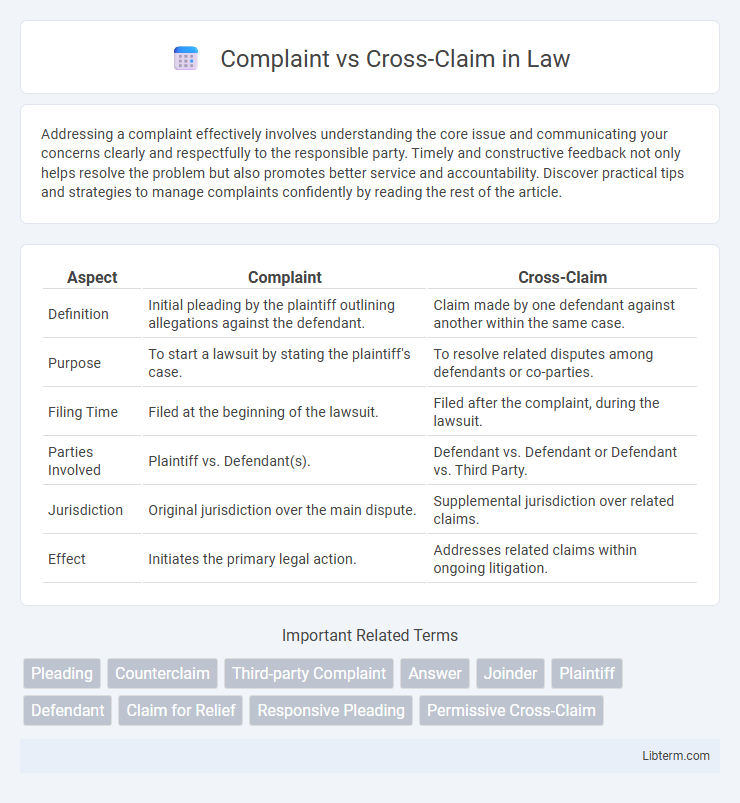Addressing a complaint effectively involves understanding the core issue and communicating your concerns clearly and respectfully to the responsible party. Timely and constructive feedback not only helps resolve the problem but also promotes better service and accountability. Discover practical tips and strategies to manage complaints confidently by reading the rest of the article.
Table of Comparison
| Aspect | Complaint | Cross-Claim |
|---|---|---|
| Definition | Initial pleading by the plaintiff outlining allegations against the defendant. | Claim made by one defendant against another within the same case. |
| Purpose | To start a lawsuit by stating the plaintiff's case. | To resolve related disputes among defendants or co-parties. |
| Filing Time | Filed at the beginning of the lawsuit. | Filed after the complaint, during the lawsuit. |
| Parties Involved | Plaintiff vs. Defendant(s). | Defendant vs. Defendant or Defendant vs. Third Party. |
| Jurisdiction | Original jurisdiction over the main dispute. | Supplemental jurisdiction over related claims. |
| Effect | Initiates the primary legal action. | Addresses related claims within ongoing litigation. |
Understanding Complaints in Legal Proceedings
A complaint initiates a lawsuit by outlining the plaintiff's allegations and legal grounds against the defendant, establishing the basis for the court's jurisdiction. Understanding complaints is crucial because they set the scope of the litigation, identify parties involved, and specify the relief sought. Unlike a complaint, a cross-claim is filed by a defendant against a co-defendant or another party on the same side, addressing related issues within the same case.
Defining Cross-Claims: An Overview
Cross-claims in civil litigation involve disputes between co-defendants or co-plaintiffs arising from the same transaction or occurrence underlying the original complaint. Unlike complaints, which initiate a lawsuit by outlining the plaintiff's allegations against the defendant, cross-claims allow parties on the same side of a case to assert claims against each other. This procedural tool enhances judicial efficiency by consolidating related disputes within a single legal action, reducing the need for separate lawsuits.
Key Differences Between Complaint and Cross-Claim
A complaint is the initial legal document filed by a plaintiff to start a lawsuit, outlining the plaintiff's claims against the defendant and the relief sought. A cross-claim, however, is filed by a defendant against a co-defendant or co-plaintiff within the same case, addressing related issues or seeking additional remedies. Key differences include the timing of filing, the parties involved, and the purpose: complaints initiate action against opposing parties, while cross-claims arise within an existing case to address disputes among co-parties.
Purpose and Function of a Complaint
A complaint initiates a lawsuit by outlining the plaintiff's allegations and the legal basis for their claim against the defendant, establishing the case's scope and jurisdiction. It sets forth the facts and damages sought, serving as the primary document that triggers the court's involvement. In contrast, a cross-claim is a claim filed by a defendant against a co-defendant or co-plaintiff within the same lawsuit, aiming to address related liabilities or disputes between parties already involved.
Purpose and Function of a Cross-Claim
A complaint initiates a lawsuit by stating the plaintiff's claims against the defendant, outlining the basis for relief sought. A cross-claim, however, is filed by one defendant against another within the same lawsuit, addressing related issues or liabilities among co-defendants or co-parties. The primary function of a cross-claim is to resolve disputes between parties on the same side of the original complaint, promoting judicial efficiency by consolidating related claims into a single proceeding.
Legal Requirements for Filing a Complaint
Filing a complaint requires the plaintiff to clearly state the legal grounds for the lawsuit, specify the facts supporting those claims, and identify the parties involved, all adhering to the jurisdiction's procedural rules. The complaint must include a demand for relief, outlining what remedy the plaintiff seeks from the court. Proper service of the complaint to the defendant is crucial to establish the court's jurisdiction and initiate the litigation process.
Legal Standards for Filing a Cross-Claim
A cross-claim must arise from the same transaction or occurrence as the original complaint and involve a co-party in the lawsuit, adhering to Federal Rule of Civil Procedure 13(g). The legal standard requires that the cross-claim relates directly to the subject matter of the primary claim, ensuring judicial efficiency and consistency in adjudicating interconnected disputes. Unlike a complaint that initiates a lawsuit, a cross-claim is filed within an existing case to resolve issues among co-defendants or co-plaintiffs under a unified procedural framework.
Procedural Steps: Complaint vs. Cross-Claim
A complaint initiates a lawsuit by outlining the plaintiff's allegations and requesting relief, requiring the defendant to respond within a specified timeframe, typically 21 days. A cross-claim arises within the same litigation, filed by one defendant against another defendant or among co-defendants, addressing related issues and governed by procedural rules such as Rule 13(g) of the Federal Rules of Civil Procedure. Both pleadings require strict adherence to procedural steps, including proper filing, service to parties, and timely responses to preserve rights and support case progression.
Common Scenarios Involving Complaints and Cross-Claims
Complaints typically arise when a plaintiff initiates a lawsuit seeking remedy for alleged harm caused by the defendant, such as breach of contract or personal injury claims. Cross-claims occur between co-defendants or co-plaintiffs within the same lawsuit, often involving disputes over liability distribution or contractual interpretation related to the original complaint. Common scenarios include multi-party construction defects cases where one contractor sues another through a cross-claim, while the property owner files a complaint against both contractors.
Strategic Considerations in Choosing Complaint or Cross-Claim
Selecting between a complaint and a cross-claim hinges on strategic considerations such as jurisdiction, timing, and the relationships among parties involved. Filing a complaint initiates litigation and asserts claims against defendants, establishing control over the scope of the case. Conversely, a cross-claim targets co-defendants or co-plaintiffs within the same action, optimizing judicial efficiency and consolidating related disputes to strengthen legal positioning.
Complaint Infographic

 libterm.com
libterm.com